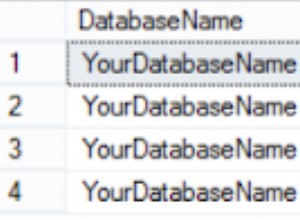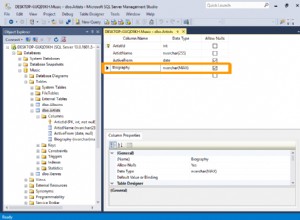Ich habe meine Antwort in der ersten Frage geändert...
Am besten wäre es, wenn Ihre Tabelle die Beziehungsdaten direkt in indizierten Spalten halten würde. Bevor Sie die Struktur Ihrer Tabelle ändern, können Sie Folgendes versuchen:
Eine Tabelle mit Testdaten
DECLARE @tbl TABLE ( AccountID VARCHAR(100), AccountName VARCHAR(100));
INSERT INTO @tbl VALUES
('11','Acc11')
,('12','Acc12')
,('13','Acc13')
,('11/11','Acc11/11')
,('11/12','Acc11/12')
,('11/111','Acc11/111')
,('11/11/001','Acc11/11/001')
,('11/11/002','Acc11/11/002')
,('12/111','Acc12/111')
,('12/112','Acc12/112');
Dadurch werden die erforderlichen Daten in eine neu erstellte temporäre Tabelle mit dem Namen #tempHierarchy übertragen
SELECT AccountID
,AccountName
,ROW_NUMBER() OVER(ORDER BY LEN(AccountID)-LEN(REPLACE(AccountID,'/','')),AccountID) AS ID
,Extended.HierarchyLevel
,STUFF(
(
SELECT '/' + A.B.value('.','varchar(10)')
FROM Extended.IDsXML.nodes('/x[position() <= sql:column("HierarchyLevel")]') AS A(B)
FOR XML PATH('')
),1,2,'') AS ParentPath
,Extended.IDsXML.value('/x[sql:column("HierarchyLevel")+1][1]','varchar(10)') AS ownID
,Extended.IDsXML.value('/x[sql:column("HierarchyLevel")][1]','varchar(10)') AS ancestorID
INTO #tempHierarchy
FROM @tbl
CROSS APPLY(SELECT LEN(AccountID)-LEN(REPLACE(AccountID,'/','')) + 1 AS HierarchyLevel
,CAST('<x></x><x>' + REPLACE(AccountID,'/','</x><x>') + '</x>' AS XML) AS IDsXML) AS Extended
;
Das Zwischenergebnis
+-----------+--------------+----+----------------+------------+-------+------------+
| AccountID | AccountName | ID | HierarchyLevel | ParentPath | ownID | ancestorID |
+-----------+--------------+----+----------------+------------+-------+------------+
| 11 | Acc11 | 1 | 1 | | 11 | |
+-----------+--------------+----+----------------+------------+-------+------------+
| 12 | Acc12 | 2 | 1 | | 12 | |
+-----------+--------------+----+----------------+------------+-------+------------+
| 13 | Acc13 | 3 | 1 | | 13 | |
+-----------+--------------+----+----------------+------------+-------+------------+
| 11/11 | Acc11/11 | 4 | 2 | 11 | 11 | 11 |
+-----------+--------------+----+----------------+------------+-------+------------+
| 11/111 | Acc11/111 | 5 | 2 | 11 | 111 | 11 |
+-----------+--------------+----+----------------+------------+-------+------------+
| 11/12 | Acc11/12 | 6 | 2 | 11 | 12 | 11 |
+-----------+--------------+----+----------------+------------+-------+------------+
| 12/111 | Acc12/111 | 7 | 2 | 12 | 111 | 12 |
+-----------+--------------+----+----------------+------------+-------+------------+
| 12/112 | Acc12/112 | 8 | 2 | 12 | 112 | 12 |
+-----------+--------------+----+----------------+------------+-------+------------+
| 11/11/001 | Acc11/11/001 | 9 | 3 | 11/11 | 001 | 11 |
+-----------+--------------+----+----------------+------------+-------+------------+
| 11/11/002 | Acc11/11/002 | 10 | 3 | 11/11 | 002 | 11 |
+-----------+--------------+----+----------------+------------+-------+------------+
Und nun erfolgt ein ähnlich rekursiver Ansatz wie in meiner ersten Antwort. Aber - da es jetzt eine echte Tabelle verwendet und das ganze String-Splitting bereits stattgefunden hat - sollte es schneller sein ...
WITH RecursiveCTE AS
(
SELECT th.*
,CAST(NULL AS BIGINT) AS ParentID
,CASE WHEN EXISTS(SELECT 1 FROM #tempHierarchy AS x WHERE x.ParentPath=th.AccountID) THEN 1 ELSE 0 END AS HasChild
FROM #tempHierarchy AS th WHERE th.HierarchyLevel=1
UNION ALL
SELECT sa.AccountID
,sa.AccountName
,sa.ID
,sa.HierarchyLevel
,sa.ParentPath
,sa.ownID
,sa.ancestorID
,(SELECT x.ID FROM #tempHierarchy AS x WHERE x.AccountID=sa.ParentPath)
,CASE WHEN EXISTS(SELECT 1 FROM #tempHierarchy AS x WHERE x.ParentPath=sa.AccountID) THEN 1 ELSE 0 END AS HasChild
FROM RecursiveCTE AS r
INNER JOIN #tempHierarchy AS sa ON sa.HierarchyLevel=r.HierarchyLevel+1
AND r.AccountID=sa.ParentPath
)
SELECT r.AccountID
,r.AccountName
,r.ID
,r.ParentID
,r.HierarchyLevel
,r.HasChild
FROM RecursiveCTE AS r
ORDER BY HierarchyLevel,ParentID;
Und endlich räume ich auf
DROP TABLE #tempHierarchy;
Und hier ist das Endergebnis
+-----------+--------------+----+----------+----------------+----------+
| AccountID | AccountName | ID | ParentID | HierarchyLevel | HasChild |
+-----------+--------------+----+----------+----------------+----------+
| 11 | Acc11 | 1 | NULL | 1 | 1 |
+-----------+--------------+----+----------+----------------+----------+
| 12 | Acc12 | 2 | NULL | 1 | 1 |
+-----------+--------------+----+----------+----------------+----------+
| 13 | Acc13 | 3 | NULL | 1 | 0 |
+-----------+--------------+----+----------+----------------+----------+
| 11/11 | Acc11/11 | 4 | 1 | 2 | 1 |
+-----------+--------------+----+----------+----------------+----------+
| 11/111 | Acc11/111 | 5 | 1 | 2 | 0 |
+-----------+--------------+----+----------+----------------+----------+
| 11/12 | Acc11/12 | 6 | 1 | 2 | 0 |
+-----------+--------------+----+----------+----------------+----------+
| 12/111 | Acc12/111 | 7 | 2 | 2 | 0 |
+-----------+--------------+----+----------+----------------+----------+
| 12/112 | Acc12/112 | 8 | 2 | 2 | 0 |
+-----------+--------------+----+----------+----------------+----------+
| 11/11/001 | Acc11/11/001 | 9 | 4 | 3 | 0 |
+-----------+--------------+----+----------+----------------+----------+
| 11/11/002 | Acc11/11/002 | 10 | 4 | 3 | 0 |
+-----------+--------------+----+----------+----------------+----------+




